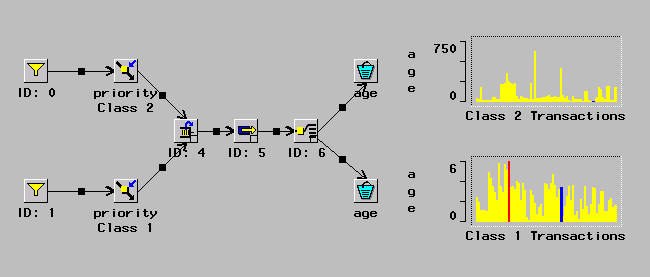Chapter Contents
Previous
Next
|
Chapter Contents |
Previous |
Next |
| Selected Examples |

|
The two classes of transactions arrive according to independent Poisson processes as represented by the two Samplers. Transactions travel to Modifiers that set the priority to be either a 1 or a 2. They then enter a Priority Queue with the priority level determining their position in the queue; the higher priority transactions are serviced before the lower priority transactions. When the transactions finish service, they enter a Switch that directs them to one of two Buckets as a function of priority class.
The model in Figure 9.5 assumes that if a Class 1 transaction is in service when a Class 2 transaction arrives, the Class 1 transaction completes service before the Class 2 transaction starts service ahead of any other Class 1 transactions in the queue. Figure 9.6 shows how you would modify the model if you wanted to pre-empt a Class 1 transaction that was in service when a Class 2 arrived.

|
For this pre-emption, you would store the class of the transaction currently in service in a number holder. This storage is done by the trigger just below the number holder. Then, when a Class 2 transaction arrives, it causes a check of the class of the transaction in service. If it is Class 1, then it is pre-empted. Notice that any pre-empted Class 1 transactions are routed back into the queue.
|
Chapter Contents |
Previous |
Next |
Top |
Copyright © 1999 by SAS Institute Inc., Cary, NC, USA. All rights reserved.